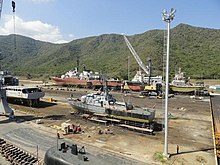This article includes a list of general references, but it lacks sufficient corresponding inline citations. (February 2022) |
DIANCA or National Docks and Shipyards C.A. (Spanish: Diques y Astilleros Nacionales Compañía Anónima) is the state-owned shipyard of the Bolivarian Republic of Venezuela. It was created in 1905 in the city of Puerto Cabello, Carabobo.



DIANCA was established by Presidential Decree as a subsidiary of the Venezuelan Ministry of Defense, then called the Ministry of War and Navy. It provides important maintenance to most of the Bolivarian Navy of Venezuela, but also to private companies and other state-owned companies such as Petroleum of Venezuela. Its current president is Rear Admiral Luis Enrique Castillo. It has also built boats mostly in kit form from the Damen Group shipyards and is currently working with Navantia to build some of the new 2000 tonne patrol boats. DIANCA is being a paradigm in the development of the Venezuelan shipbuilding industry. The establishment of an agreement with Argentina, Brazil and Spain, among other countries, resulted in the exchange of trained and specialized labor and the transfer of German technology, as in the case of Major Maintenance of the Sábalo-class submarines. Regarding Venezuela, the participants of the aforementioned exchange will be selected according to a matrix approved by the Board of Directors and for a few months Venezuelan personnel have been training in the repowering of submarines. DIANCA, in the agreements it carries out, requires that all those supplies (plates, pipes, cables, etc.) that are produced in Venezuela and be acquired in the country in order to strengthen the national industry. In addition to this, the possibility of carrying out projects for the construction of asphalt ships, coast guard patrol boats and expansion of the PDV fleet will promote the consolidation of others and therefore, will generate sources of work for the Venezuelan people. Although it is true that a year after its inauguration, National Docks and Shipyards caused a great impact in the Caribbean area, as time passed, this effect diminished until the beginning of the year 2000, which headed towards the third millennium and headed towards the century of its creation, a process of creating a holding company with other large shipyards to obtain a real transfer of technology, knowledge and external training and at an internal level to optimize the availability of machinery and equipment in order to maximize the company's production system. In the war memory y Marine Corresponding to the year 1913, the evaluation made by the government was expressed as follows: "...with all the personal and material elements to carry out works of the first magnitude, the ships of the Navy can be repaired quickly and with considerable economy in expenses, leaving beyond any doubt the advantages that the nation reports by having the means to repair its Navy always in its waters without the delays, excess expenses and other inconveniences that resulted when there was a need. "... to send their ships to foreign shipyards"... Today, when major maintenance is carried out in the country on two Mariscal Sucre-class missile frigates with the participation of national labor and strategic alliances with private companies, opening jobs for the community of Puerto Cabello, Borburata, San Esteban and other surrounding towns and the other projects already underway, agree or to the Bolivarian ideal of endogenous development, its maximum example being the Project for the Major Repowering of the Sábalo-class submarines, which, for the first time in Venezuela, is carrying out a technological transfer to higher levels of technology as developed as the German one that is being transferred to the workers and professionals of DIANCA, becoming the solid base for the consolidation of the Venezuelan naval industry together with indigenous initiatives such as the first time in Venezuela the wheels used in the Syncrolift (syncroelevator) were built, which is one of the stranding facilities owned by the shipyard for the repair, construction, reporting and maintenance processes of vessels of up to 5,000 tons. the wheels were built in the company FUNDICIÓN METALÚRGICA LEMOS, located in Barquisimeto, Lara State, under strict quality standards and the construction of 915 docking cars, 1080 connectors of different lengths and which were built in the company Fabricaciones Industriales, C.A. (FAINCA), located in Valencia, Carabobo state, the new Venezuela has charted its course towards the consolidation and international projection of its shipbuilding industry. In dianca they also offer other types of services such as the filling of Oxygen Pumps, Equipment and parts supply service.